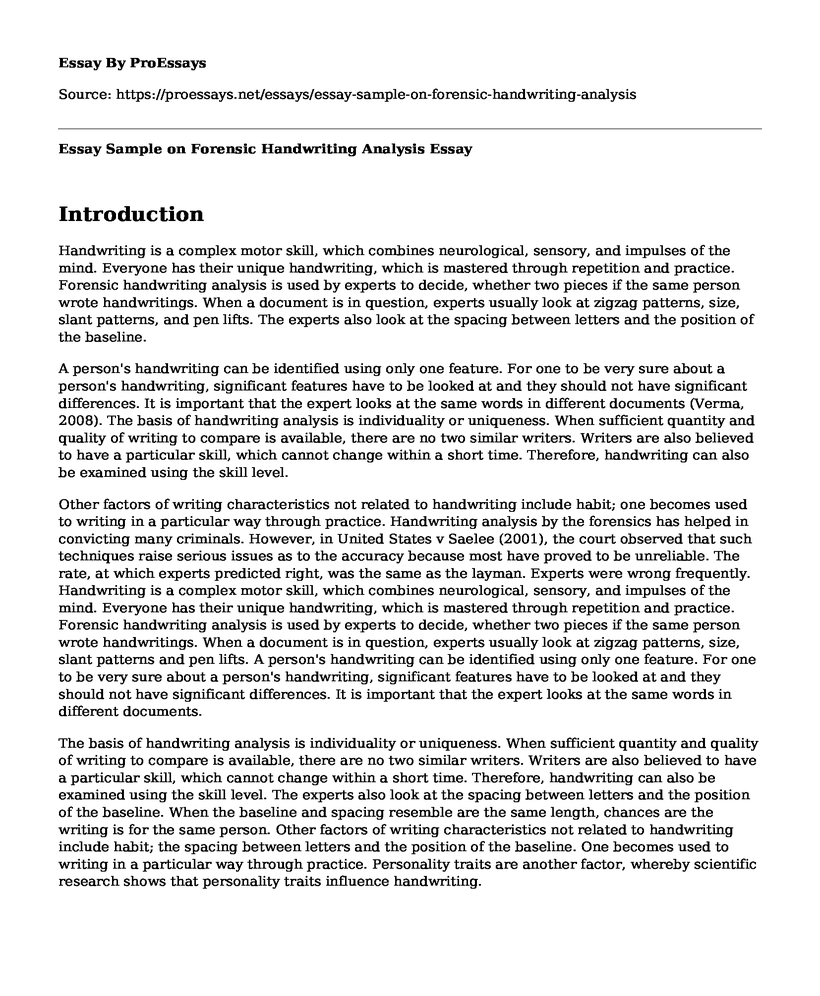Introduction
Handwriting is a complex motor skill, which combines neurological, sensory, and impulses of the mind. Everyone has their unique handwriting, which is mastered through repetition and practice. Forensic handwriting analysis is used by experts to decide, whether two pieces if the same person wrote handwritings. When a document is in question, experts usually look at zigzag patterns, size, slant patterns, and pen lifts. The experts also look at the spacing between letters and the position of the baseline.
A person's handwriting can be identified using only one feature. For one to be very sure about a person's handwriting, significant features have to be looked at and they should not have significant differences. It is important that the expert looks at the same words in different documents (Verma, 2008). The basis of handwriting analysis is individuality or uniqueness. When sufficient quantity and quality of writing to compare is available, there are no two similar writers. Writers are also believed to have a particular skill, which cannot change within a short time. Therefore, handwriting can also be examined using the skill level.
Other factors of writing characteristics not related to handwriting include habit; one becomes used to writing in a particular way through practice. Handwriting analysis by the forensics has helped in convicting many criminals. However, in United States v Saelee (2001), the court observed that such techniques raise serious issues as to the accuracy because most have proved to be unreliable. The rate, at which experts predicted right, was the same as the layman. Experts were wrong frequently. Handwriting is a complex motor skill, which combines neurological, sensory, and impulses of the mind. Everyone has their unique handwriting, which is mastered through repetition and practice. Forensic handwriting analysis is used by experts to decide, whether two pieces if the same person wrote handwritings. When a document is in question, experts usually look at zigzag patterns, size, slant patterns and pen lifts. A person's handwriting can be identified using only one feature. For one to be very sure about a person's handwriting, significant features have to be looked at and they should not have significant differences. It is important that the expert looks at the same words in different documents.
The basis of handwriting analysis is individuality or uniqueness. When sufficient quantity and quality of writing to compare is available, there are no two similar writers. Writers are also believed to have a particular skill, which cannot change within a short time. Therefore, handwriting can also be examined using the skill level. The experts also look at the spacing between letters and the position of the baseline. When the baseline and spacing resemble are the same length, chances are the writing is for the same person. Other factors of writing characteristics not related to handwriting include habit; the spacing between letters and the position of the baseline. One becomes used to writing in a particular way through practice. Personality traits are another factor, whereby scientific research shows that personality traits influence handwriting.
Conclusion
In conclusion, handwriting analysis by the forensics has helped in convicting many criminals. However, in United States v Saelee (2001), the court observed that such techniques raise serious issues as to the accuracy because most have proved to be unreliable. The rate, at which experts predicted right, was the same as the layman. Experts were wrong frequently.
References
Verma, B. (Ed.). (2008). Pattern Recognition Technologies and Applications: Recent Advances: Recent Advances. IGI Global
Cite this page
Essay Sample on Forensic Handwriting Analysis. (2022, May 16). Retrieved from https://proessays.net/essays/essay-sample-on-forensic-handwriting-analysis
If you are the original author of this essay and no longer wish to have it published on the ProEssays website, please click below to request its removal:
- Creative Writing: A Photographer Goes on a Killing Spree
- Essay Sample on Violent, Property and White-Collar Crimes
- Essay Sample on Technology on the Border
- Adarand Constructors, Inc. v Pena (1995): Race-Based Contract Allocation Case
- Lodzinski Murder Trial: A Critical Point in History - Essay Sample
- Free Paper Example: University of Virginia Violates Human Cloning Act HCA
- Should Euthanasia Be Legalized? An Argumentative Essay Example







